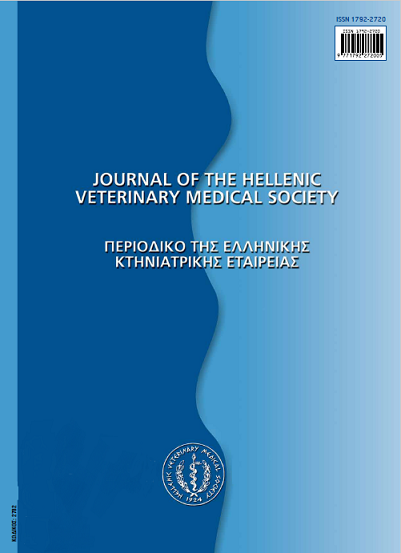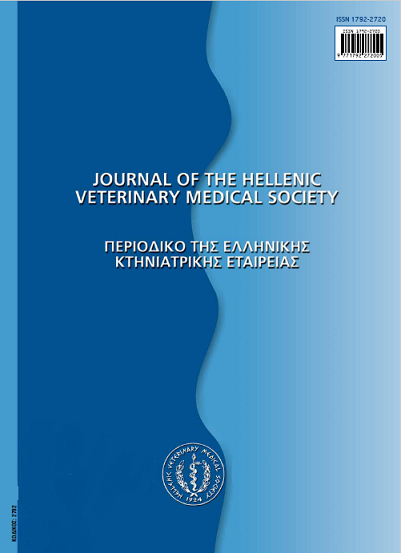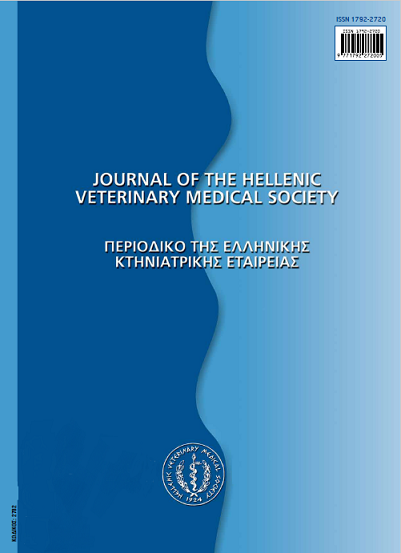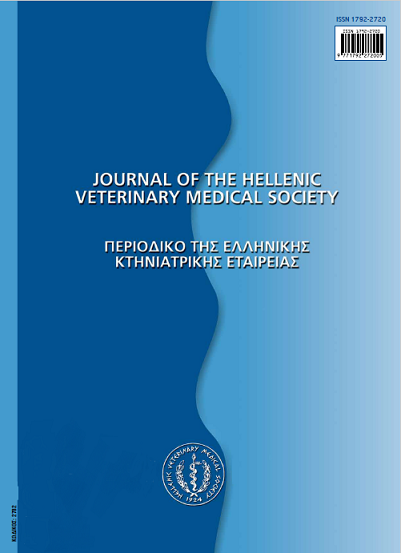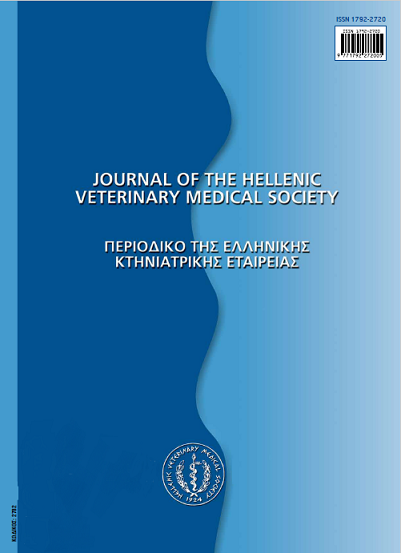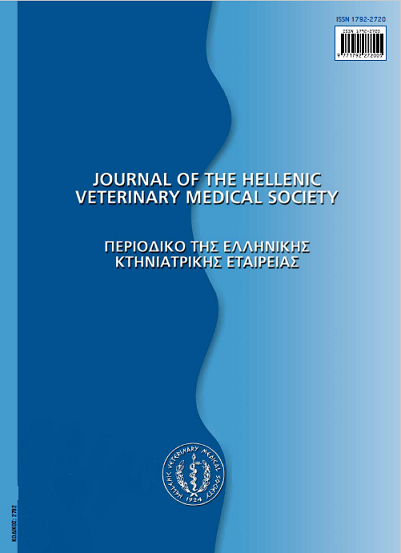Χρήση των τεχνικών πολλαπλής ωοθυλακιορρηξίας, κατάψυξης και μεταφοράς εμβρύων για τη διακίνηση γενετικού υλικού μεταξύ χωρών

Περίληψη
Αντικείμενο της εργασίας ήταν η αξιολόγηση τωντεχνικών πολλαπλής ωοθυλακιορρηξίας, κατάψυξης και μεταφοράς εμβρύων από μια εγχώρια γαλακτοπαραγωγό φυλή προβάτων. Χρησιμοποιήθηκαν 50 προβατίνες Καραγκούνικης φυλής. Ο συγχρονισμός του οίστρου έγινε με τη χρήση ενδοκολπικών σπόγγων εμποτισμένωνμε προγεσταγόνα, ενώ για την πρόκληση πολλαπλής ωοθυλακιορρηξίας χρησιμοποιήθηκε ομόλογος ωοθυλακιοτρόπος ορμόνη(oFSH). Έξι ημέρες μετά τη λαπαροσκοπική σπερματέγχυση μενωπό σπέρμα, έγινε συλλογή εμβρύων χειρουργικά, και αφού εκτιμήθηκεη ποιότητα τους, καταψύχθηκαν. Οι προβατίνες που χρησιμοποιήθηκανως δότριες είχαν ένα μέσο δείκτη ωοθυλακιορρηξίας 11,9 (s.e. 0,89). Το ποσοστό των ωαρίων που συλλέχτηκαν ήταν 80,9% και η γονιμότητα τους έφτασε το 87,6%. Περίπου 327 (77,5%) από τα βιώσιμα έμβρυα κρίθηκαν κατάλληλα για κατάψυξη.Τα στάδια ανάπτυξης των εμβρύων, που συλλέχτηκαν, ήταν από του όψιμου μοριδίου έως της πλήρους βλαστοκυστης και η κατάψυξη τους έγινε σε τρία επίπεδα σε 1.5Μ αιθυλική γλυκόλη, μετά από επανειλημμένα πλυσίματα και επεξεργασία με θρυψίνη. Μετά την κατάψυξη τους τα έμβρυα μεταφέρθηκαν στο Ηνωμένο Βασίλειο (Σκωτία). Το Δεκέμβριο του ιδίου έτους, τα έμβρυα αποψύχτηκαν γρήγορα και επανενυδατώθηκαν σε δυο στάδια με βαθμιαία προσθήκη σουκρόζης/αιθυλικής γλυκόλης. 92,4% των κατεψυγμένων εμβρύων παρέμειναν κατάλληλα και μεταφέρθηκαν, χειρουργικά, σε προβατίνες δέκτες της φυλής Scottish Blackface που είχαν υποστεί συγχρονισμό οίστρου. Συνολικά μεταφέρθηκαν 183 έμβρυα με βιωσιμότητα 66,1%. Η βιωσιμότητα των κατεψυγμένων βλαστοκυστεων (75%) που αποψύχτηκαν ήταν σημαντικά υψηλότερη (Ρ<0.01) από εκείνη των μοριδίων (48%). Συμπεραίνεται, ότι τα κατεψυγμένα έμβρυα μπορούν να αποτελέσουν ένα επιτυχές μέσο για τη μεταφορά πρόβειου γενετικού υλικού από και προς την Ελλάδα. Πρέπει, όμως, κατά την επιλογή των εμβρύων να δίνεται ιδιαίτερη σημασία στο στάδιο ανάπτυξης τους, αφού φαίνεται ότι αποτελεί παράγοντα αποφασιστικής σημασίας για την επιτυχία της μεθόδου.
Λεπτομέρειες άρθρου
- Πώς να δημιουργήσετε Αναφορές
-
STAMATARIS (Κ. ΣΤΑΜΑΤΑΡΗΣ) K., DELIGIANNIS (Κ. ΔΕΛΗΓΙΑΝΝΗΣ) K., LAINAS (Θ. ΛΑΪΝΑΣ) T., & ARSENOS (Γ. ΑΡΣΕΝΟΣ) G. (2018). Χρήση των τεχνικών πολλαπλής ωοθυλακιορρηξίας, κατάψυξης και μεταφοράς εμβρύων για τη διακίνηση γενετικού υλικού μεταξύ χωρών. Περιοδικό της Ελληνικής Κτηνιατρικής Εταιρείας, 53(3), 237–246. https://doi.org/10.12681/jhvms.15378
- Τεύχος
- Τόμ. 53 Αρ. 3 (2002)
- Ενότητα
- Research Articles

Αυτή η εργασία είναι αδειοδοτημένη υπό το CC Αναφορά Δημιουργού – Μη Εμπορική Χρήση 4.0.
Οι συγγραφείς των άρθρων που δημοσιεύονται στο περιοδικό διατηρούν τα δικαιώματα πνευματικής ιδιοκτησίας επί των άρθρων τους, δίνοντας στο περιοδικό το δικαίωμα της πρώτης δημοσίευσης.
Άρθρα που δημοσιεύονται στο περιοδικό διατίθενται με άδεια Creative Commons 4.0 Non Commercial και σύμφωνα με την άδεια μπορούν να χρησιμοποιούνται ελεύθερα, με αναφορά στο/στη συγγραφέα και στην πρώτη δημοσίευση για μη κερδοσκοπικούς σκοπούς.
Οι συγγραφείς μπορούν να καταθέσουν το άρθρο σε ιδρυματικό ή άλλο αποθετήριο ή/και να το δημοσιεύσουν σε άλλη έκδοση, με υποχρεωτική την αναφορά πρώτης δημοσίευσης στο J Hellenic Vet Med Soc
Οι συγγραφείς ενθαρρύνονται να καταθέσουν σε αποθετήριο ή να δημοσιεύσουν την εργασία τους στο διαδίκτυο πριν ή κατά τη διαδικασία υποβολής και αξιολόγησής της.



